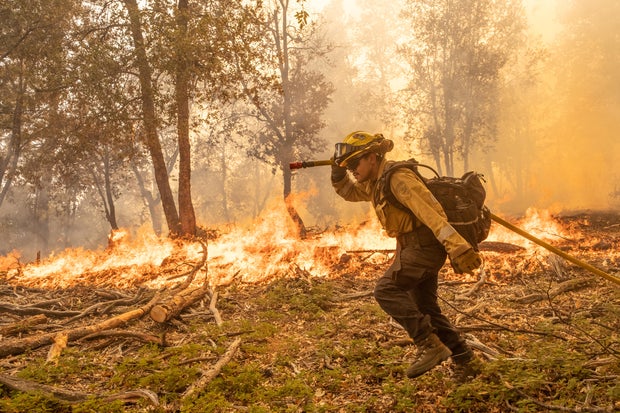A fierce California wildfire expanded Monday, burning thousands of acres and forcing evacuations as tens of millions of Americans suffocated. scorching heat the weekend. More than 2,000 firefighters supported by 17 helicopters have been deployed against the Oak Fire, which broke out near Yosemite National Park on Friday, according to the California Department of Forestry and Fire Protection, or Cal Fire.
But three days after it started, the fire has already consumed more than 16,700 hectares and was 10% contained as of Monday morning. the agency said.
“Extreme drought conditions have resulted in critical fuel moisture levels,” according to Cal Fire.
Described as “explosive” by officials, the fire has left ash, gutted vehicles and twisted remains of property in its wake as emergency personnel worked to evacuate residents and protect structures in its path.
It has already damaged or destroyed 15 properties, with thousands of homes and businesses threatened, CBS News correspondent Jonathan Vigliotti reports.
Smoke from the fire, which can be seen from the International Space Station, prompted an air quality advisory for the San Francisco Bay Area on Monday, Vigliotti reports.
David Odisho/Bloomberg via Getty Images
More than 6,000 people had been evacuated, Cal Fire official Hector Vasquez said, and the Oak Fire is the state’s largest so far.
California firefighters have been dispatched to more than 4,000 wildfires this year.
“The cycle of fire up here, before those 1,500 years droughts that we’re in, it was like a big one every 15 to 20 years, now we have multiple big fires every year,” Beth Pratt, regional executive director of the National Wildlife Federation, told Vigliotti. “It’s scary, it’s absolutely scary. .”
Lynda Reynolds-Brown and her husband Aubrey waited for news about the fate of their home from an evacuation center at an elementary school. They fled as ash rained down and the fire raced down a hill toward their property.
“It looked like it was over our house and it was coming really fast,” Reynolds-Brown told KCRA-TV.
California Gov. Gavin Newsom declared a state of emergency in Mariposa County on Saturday, citing “extremely dangerous conditions for the safety of people and property.”
In recent years, California and other parts of the western United States have been ravaged by huge and fast-moving wildfires, fueled by years of drought and a warming climate.
Evidence of global warming could be seen elsewhere in the country, as 85 million Americans in more than a dozen states were under a weekend heat advisory.
The crisis prompted former Vice President Al Gore, a tireless climate advocate, to issue stern warnings on Sunday about “inaction” by lawmakers.
Asked if he thinks President Biden should declare a climate emergency, which would give him additional policy powers, Gore was blunt.
“Mother Nature has already declared it a global emergency,” he told ABC News on the “This Week” talk show.
And “it has to get much, much worse and quickly,” he told NBC separately.
But he also suggested that recent crises, including deadly ones heat waves in Europe, could serve as a wake-up call to members of Congress who have so far refused to embrace efforts to combat climate change.
“I think these extreme events that are steadily getting worse and more severe are really starting to change minds,” he said.
The central and northeastern regions have been bearing the brunt of the extreme heat, which is expected to ease somewhat on Monday.
“Intense heat will continue across the Mid-Atlantic and Northeast tonight before the upper Canadian trough moves down the region to somewhat moderate temperatures tomorrow,” the National Weather Service said Sunday afternoon.
But not all regions are expected to cool: Temperatures of 100 degrees Fahrenheit or more are expected in the coming days from parts of eastern Kansas and Oklahoma to southern Missouri and northern Arkansas.
Not even the frigid Pacific Northwest will escape the far-reaching heat, with high temperatures “expected to rise steadily over the next few days, bringing the potential for record breaking” , the weather service added.
Cities have been forced to open cooling stations and increase attention to at-risk communities such as the homeless and those without access to air conditioning.
Several regions of the world have been hit by extreme heatwaves in recent months, including Western Europe in July and India in March to April, incidents that scientists say are an unmistakable sign of warming climatic
Month
[ad_2]
Source link






